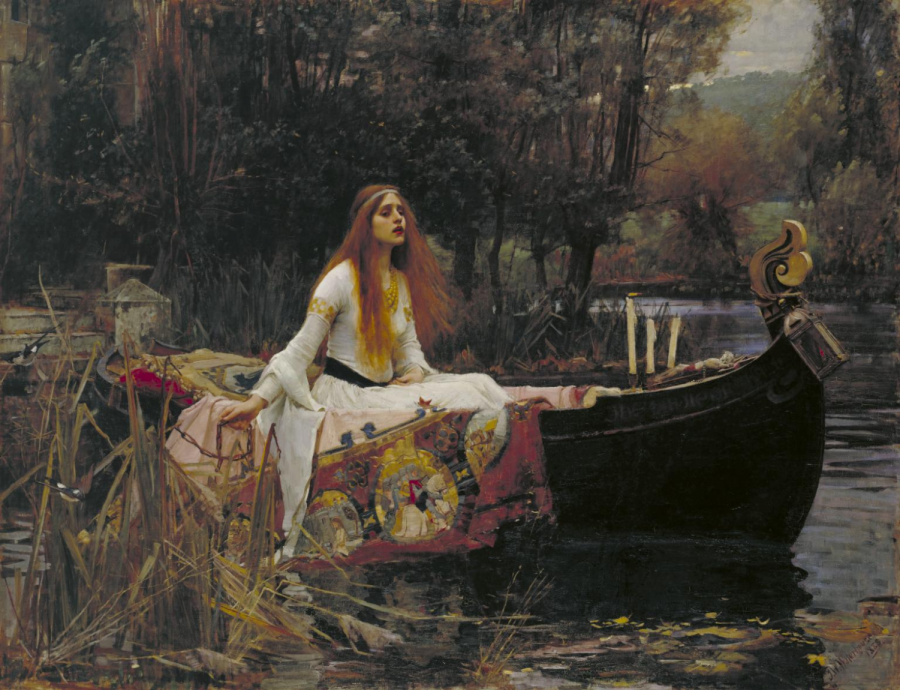Is the ‘Lady of Shalott’ a Feminist Allegory?
September 27, 2021
Most scholars have defined allegory as a narration or description in which events, actions, characters, settings or objects represent specific abstractions or ideas. This can be expressed through several forms of art namely, poetry.
Relating to this is Alfred Lord Tennyson’s poem The Lady of Shalott, a prime example of allegorical storytelling. Written in 1832, the poem’s setting and wordplay reflects the attitudes towards women both in Tennyson’s time, as well as during the medieval setting of the poem.
Through its use of Arthurian references, picturesque symbology and two alternate endings, Tennyson is able to create a meaningful, prose focused on representing the shifting ideas of his time.
The poem’s setting and “plot” follows a fair maiden who is a prisoner in a tower on Shalott, a neighboring isle to the legendary Camelot. Right off the bat, Tennyson uses his poem’s prose to draw parallels between it and the Arthurian Legends that inspire it.
For example, the titular ‘Lady’ is actually a stand-in for Elaine of Astola, a very popular character in Arthur. Tennyson’s poem itself is a direct retelling of her story, even showing the consequences of her unrequited love with one of King Arthur’s knights, Lancelot. In the story, Lancelot’s vane behaviour displays a level of narcissistic hubris, treating Lady Elaine as property.
Tennyson uses this to parallel many masculine attitudes held during his time. By using Lancelot as a stand-in for the often controlling and narcissistic beliefs held by men, he is able to show the negative consequences such control had, especially in relation to the mental and emotional state of the women that were the victims of such circumstance.
In relation to this, Tennyson uses symbolic imagery to create a multi-layered story. Many objects, people and places carry with them double meanings that strengthen Tennyson’s allegorical intentions.
For example, two of the poem’s repeating motifs are a web and a curse. The web, which is being weaved throughout the story, seems to have trapped the Lady.
Weaving was a common practice many Victorian women did in their pass time. It seems that this task has entangled the Lady, mirroring how women were trapped in the day-to-day tasks of their lives.
In relation to this, the curse also seemingly binds her to her tower, a metaphor for the binding ties of a Victorian marriage and the woman’s role in it. Similarly, the tower, which the Lady remains in for most of the story, represents the “chastity” forced upon many wives and daughters by their families.
This often resulted in them being barred away from the society they lived in. Finally, Tennyson approached the ending in a very unorthodox way: he later edited the final stanzas of the poem.
Rewritten and republished in 1842, Tennyson’s edits change the length of the story, while still retaining the mythic style of the original. This revised stanza change shifted the original meaning both for himself and for the audience.
In the original, the Lady herself has the final say, giving herself a voice (and thus free-agency) before her death. In the alternative cut, Lancelot speaks the final words. By allowing Lancelot to speak, and making the Lady silent, Tennyson removes any power the Lady might’ve had over her own circumstance.
Instead, a man of wealth and authority speaks for her, taking control of her life, and tragically, her death.
To conclude, the allegorical nature of the poem is pretty hard to dispute. Tennyson’s use of real world references and paralleling ideas help to create a strong commentary on the lives of the women in his time, using a pre-existing legend to push his own agenda.
And his later revision of the ending only further reinforces this, as the alternative conclusion touches on themes of isolation and voicelessness. By drawing parallels to his own time, Tennyson’s story acts as a cautionary tale about femininity, and a woman’s role in society.
By subtly calling out these flaws, one can (hopefully) learn from the mistakes of the author’s past, in order to shift their perspective on the present.




